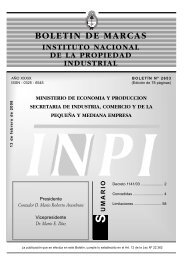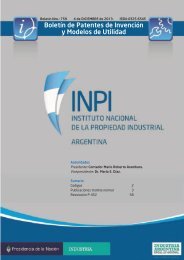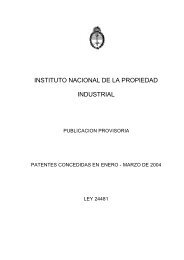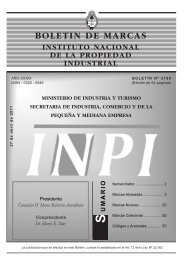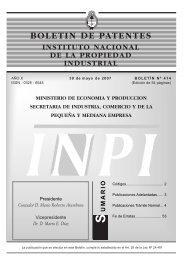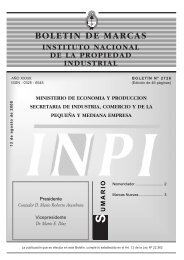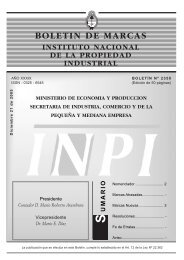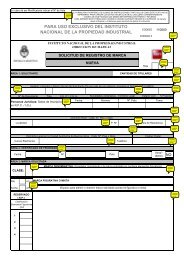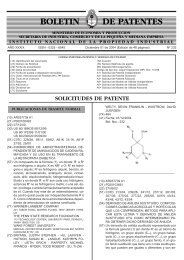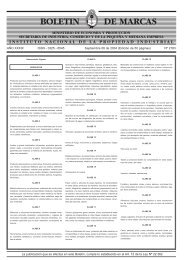2009_2 - Instituto Nacional de la Propiedad Industrial
2009_2 - Instituto Nacional de la Propiedad Industrial
2009_2 - Instituto Nacional de la Propiedad Industrial
Create successful ePaper yourself
Turn your PDF publications into a flip-book with our unique Google optimized e-Paper software.
PATENTES CONCEDIDAS <strong>2009</strong><br />
ABRIL - JUNIO<br />
___________________________________________________________________________________<br />
embriones somáticos transgénicos, y germinar<br />
dichos embriones somáticos transgénicos para<br />
producir p<strong>la</strong>ntas transgénicas.<br />
Siguen 73 reivindicaciones.<br />
#8(71) Titu<strong>la</strong>r - ARBORGEN LLC<br />
180 WESTVACO ROAD, SUMMERVILLE, SC 29484, US<br />
#8(74) Agente/s 195<br />
------------------------------------------------------------<br />
<br />
#8(10) Patente <strong>de</strong> invención<br />
#8(11) Resolución N° AR029273B1<br />
#8(21) Acta N° P 20010102982<br />
#8(22) Fecha <strong>de</strong> Presentación 22/06/2001<br />
#8(24) Fecha <strong>de</strong> resolución 17/04/<strong>2009</strong><br />
#8(--) Fecha <strong>de</strong> vencimiento 22/06/2021<br />
#8(30) Prioridad convenio <strong>de</strong> Paris<br />
PCT/SG2000/000111 01/08/2000<br />
#8(51) Int. Cl. C12N 15/29<br />
#8(54) Titulo - MOLECULA DE ADN QUE<br />
COMPRENDE UN PROMOTOR DE GEN<br />
ESPECIFICO DE FIBRA DE ALGODON Y UN<br />
TRANSGEN, Y UN METODO PARA PRODUCIR<br />
UNA PLANTA DE ALGODON TRANSFORMADA<br />
#8(57) Reivindicación 1: Una molécu<strong>la</strong> <strong>de</strong> ADN<br />
caracterizado porque compren<strong>de</strong> a) un promotor<br />
que es específico <strong>de</strong> fibras <strong>de</strong> algodón que<br />
compren<strong>de</strong> un fragmento <strong>de</strong> 1433 kb <strong>de</strong>l<br />
promotor <strong>de</strong>l gen CFTUB2 <strong>de</strong> beta-tubilina <strong>de</strong><br />
algodón que tiene <strong>la</strong> secuencia SEQ ID.Nº2 Y b)<br />
un transgen que altera <strong>la</strong>s características <strong>de</strong> <strong>la</strong><br />
fibra <strong>de</strong> algodón tal como un gen <strong>de</strong> antocianina,<br />
un gen <strong>de</strong> proteína <strong>de</strong> sea o un gen <strong>de</strong> <strong>la</strong> síntesis<br />
<strong>de</strong> polihidroxibutirato.<br />
Siguen 4 reivindicaciones.<br />
#8(71) Titu<strong>la</strong>r - TEMASEK LIFE SCIENCES<br />
LABORATORY LIMITED<br />
1 RESEARCH LINK, THE NATIONAL UNIVERSITY OF<br />
SINGAPORE, SINGAPUR 17604, SG<br />
#8(74) Agente/s 195<br />
------------------------------------------------------------<br />
<br />
#8(10) Patente <strong>de</strong> invención<br />
#8(11) Resolución N° AR042927B1<br />
#8(21) Acta N° P 20040100217<br />
#8(22) Fecha <strong>de</strong> Presentación 23/01/2004<br />
#8(24) Fecha <strong>de</strong> resolución 17/04/<strong>2009</strong><br />
#8(--) Fecha <strong>de</strong> vencimiento 23/01/2024<br />
#8(51) Int. Cl. E04H 5/08, 5/00, B65D 88/34<br />
#8(54) Titulo - UNA COBERTURA MODULAR<br />
FLOTANTE DE CONTACTO TOTAL PARA<br />
ESPEJOS LIQUIDOS, LOS MODULOS QUE LA<br />
INTEGRAN Y EL METODO PARA LA<br />
COBERTURA DE UN EMBALSADO<br />
#8(57) Reivindicación 1: Cobertura modu<strong>la</strong>r flotante <strong>de</strong><br />
contacto total para espejos líquidos, <strong>de</strong>l tipo que<br />
se encuentra en contacto con el líquido<br />
embalsado a cubrir eliminando <strong>la</strong> superficie libre<br />
<strong>de</strong>l espejo <strong>de</strong> líquido, caracterizada porque está<br />
integrada por una pluralidad <strong>de</strong> módulos<br />
individuales que se disponen en contacto total y<br />
semi sumergidos en dicho líquido y, <strong>de</strong>limitados<br />
por el perímetro <strong>de</strong> dicho espejo líquido,<br />
conforman una cobertura continua por<br />
interferencia mecánica resultante <strong>de</strong> <strong>la</strong> traba<br />
geométrica generada por <strong>la</strong> sección poligonal <strong>de</strong><br />
<strong>la</strong>s bases <strong>de</strong> los módulos; cuya cobertura<br />
continua se mantiene por <strong>la</strong> fuerza <strong>de</strong> atracción<br />
generada entre módulos contiguos, por <strong>la</strong> tensión<br />
superficial <strong>de</strong>l líquido embalsado, por <strong>la</strong><br />
flotabilidad y peso <strong>de</strong> los módulos, y, en su caso,<br />
por el coeficiente <strong>de</strong> resistencia al viento; en cuya<br />
cobertura <strong>de</strong> embalsados <strong>de</strong> formatos cuadrados<br />
o rectangu<strong>la</strong>res intervienen módulos <strong>de</strong> 4 <strong>la</strong>dos y<br />
en cuya cobertura <strong>de</strong> embalsados <strong>de</strong> formatos<br />
circu<strong>la</strong>res, ovales o irregu<strong>la</strong>res intervienen<br />
módulos <strong>de</strong> 3, 5 o más <strong>la</strong>dos, o combinaciones<br />
<strong>de</strong> ellos.<br />
Siguen 5 reivindicaciones.<br />
#8(71) Titu<strong>la</strong>r - SANDBORN ARGENTINA S.A.<br />
WERNICKE 2861 PISO 1° DTO."E", (B 1684BDG) EL<br />
PALOMAR, PROV. DE BUENOS AIRES, AR<br />
#8(72) Inventor - BEDOGNE, CARLOS DANIEL<br />
#8(74) Agente/s 988<br />
------------------------------------------------------------<br />
<br />
#8(10) Patente <strong>de</strong> invención<br />
#8(11) Resolución N° AR026742B1<br />
#8(21) Acta N° P 20000106465<br />
#8(22) Fecha <strong>de</strong> Presentación 06/12/2000<br />
#8(24) Fecha <strong>de</strong> resolución 17/04/<strong>2009</strong><br />
#8(--) Fecha <strong>de</strong> vencimiento 06/12/2020<br />
#8(51) Int. Cl. B01J 23/40, 23/00, 37/02<br />
#8(54) Titulo - COMPOSICION CATALIZADORA EN<br />
CAPAS Y PROCESOS PARA SU<br />
PREPARACION Y USO<br />
#8(57) Reivindicación 1: Una composición catalizadora<br />
en capas <strong>de</strong> conversión <strong>de</strong> hidrocarburos<br />
caracterizada porque compren<strong>de</strong> un núcleo<br />
interno, una capa externa adherida a dicho<br />
núcleo interno, estando <strong>la</strong> capa externa adherida<br />
al núcleo interno por medio <strong>de</strong> un aglomerante<br />
orgánico seleccionado <strong>de</strong>l grupo consistente <strong>de</strong><br />
alcohol polivinílico (PVA), hidroxi propil celulosa,<br />
metil celulosa y carboxi metil celulosa, en un<br />
grado tal que <strong>la</strong> perdida por <strong>de</strong>sgaste es menor al<br />
10% en peso con re<strong>la</strong>ción al peso <strong>de</strong> <strong>la</strong> capa<br />
externa en tanto <strong>la</strong> capa externa compren<strong>de</strong> un<br />
óxido inorgánico refractario externo sobre el cual,<br />
se dispersa <strong>de</strong> manera uniforme al menos un<br />
metal <strong>de</strong>l grupo <strong>de</strong> p<strong>la</strong>tino, un metal promotor y<br />
un metal modificado, don<strong>de</strong> el óxido inorgánico<br />
refractario externo es diferente <strong>de</strong> los óxidos<br />
inorgánicos que pue<strong>de</strong>n ser usados como núcleo<br />
interno, y don<strong>de</strong> el núcleo interno es<br />
11



